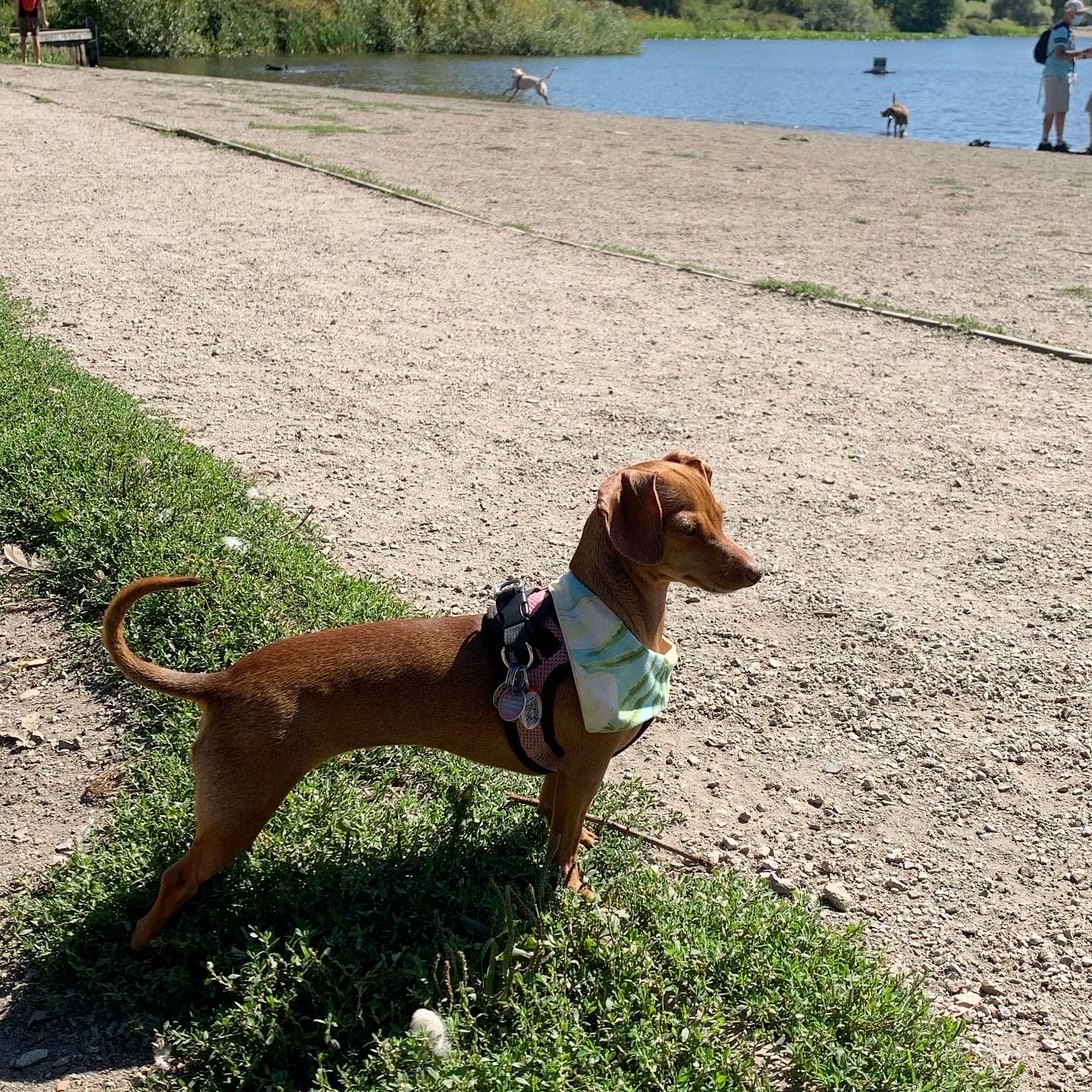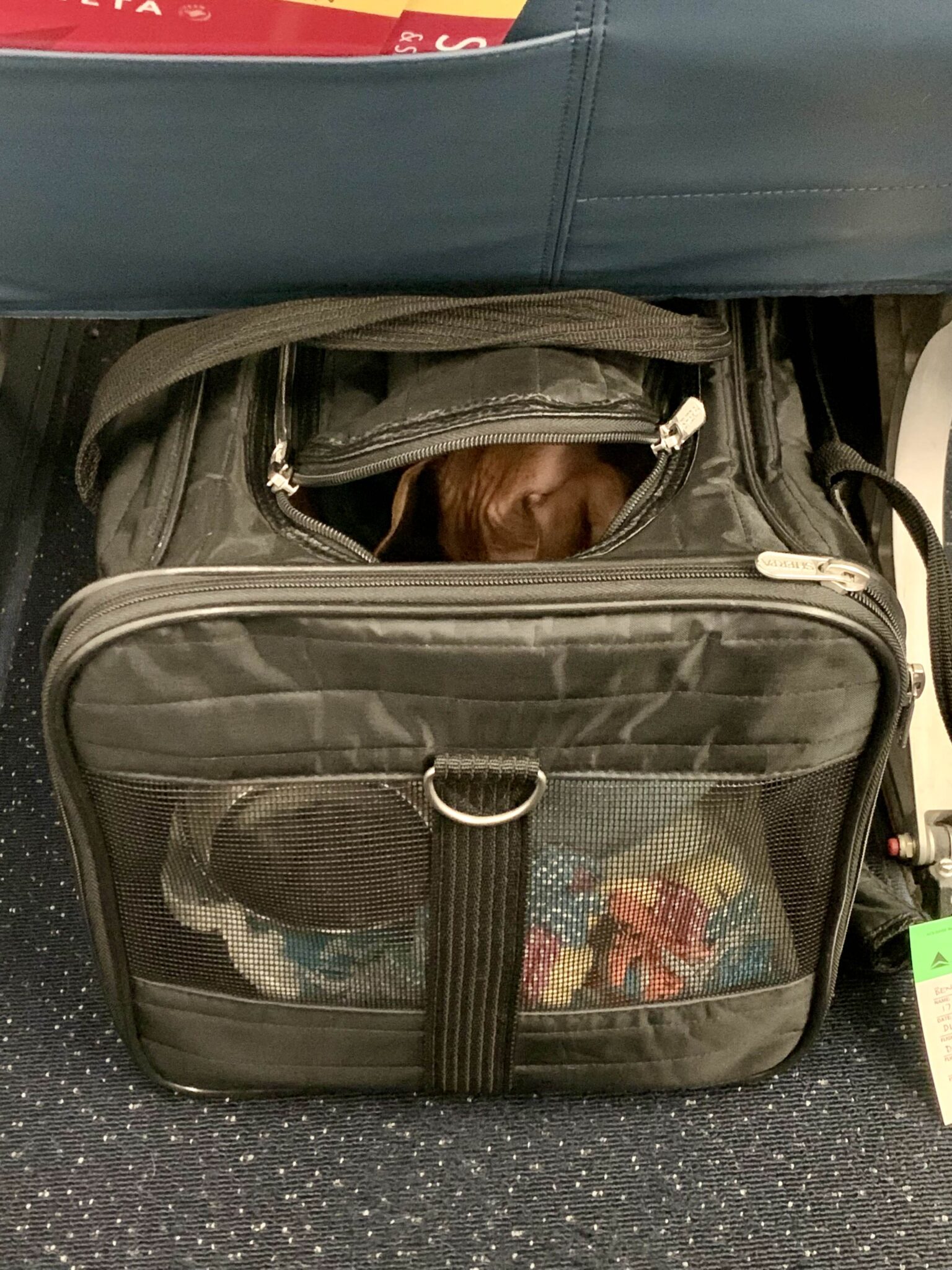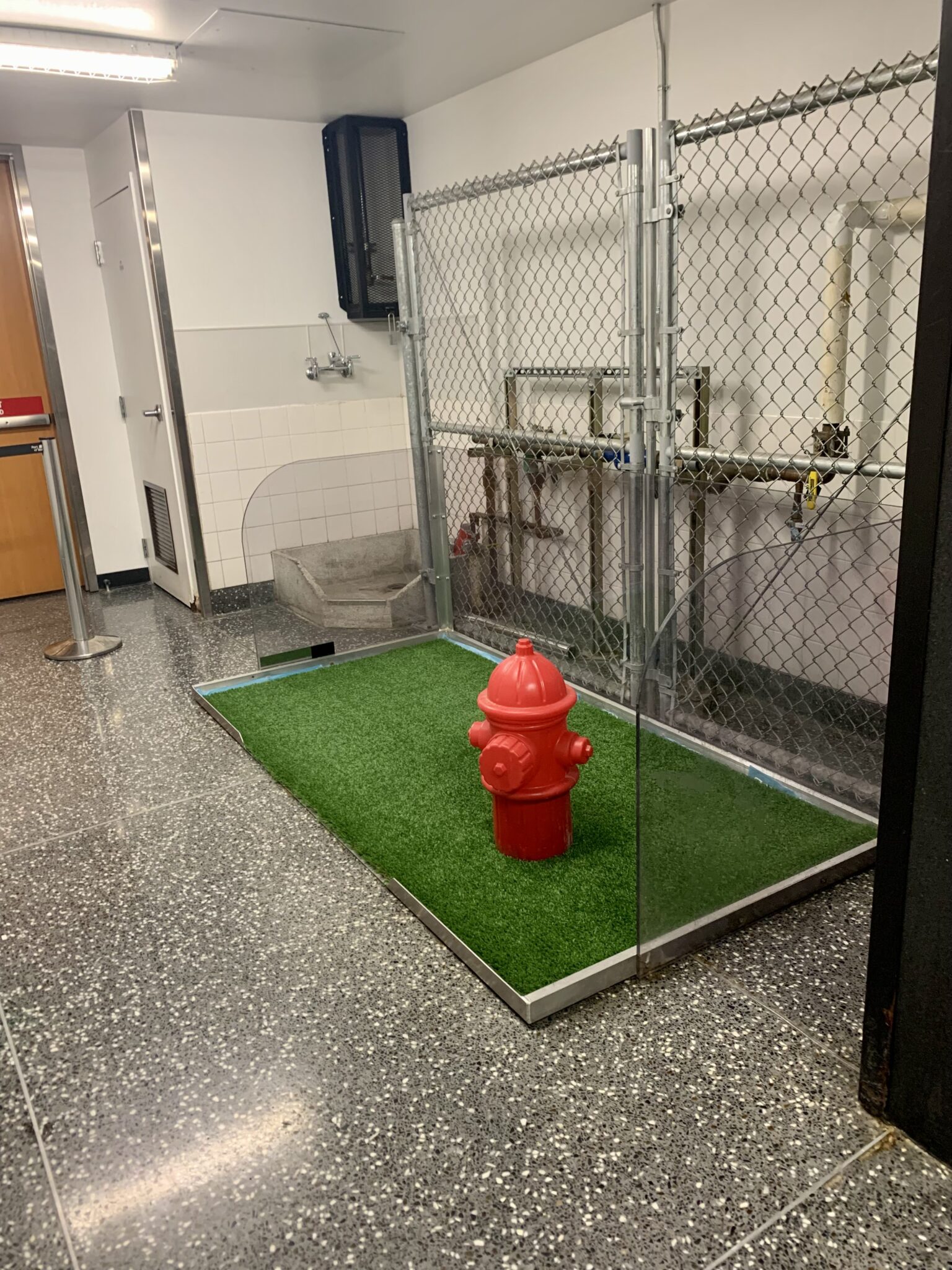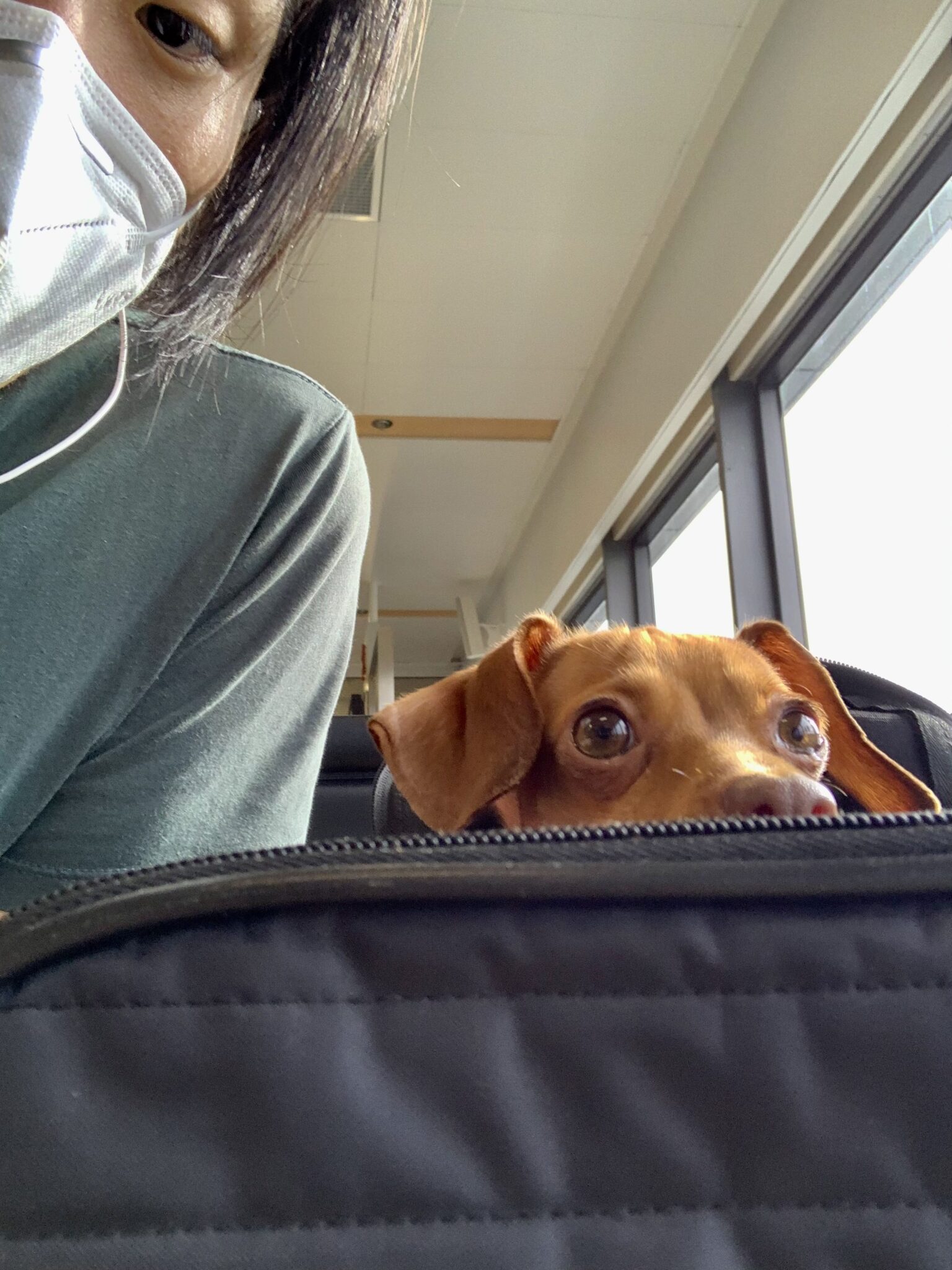Wow! It’s been a bit since the last blog post, but a pandemic will do that.
Welcome back to Expat-terns, featuring down-to-earth travel articles, tips, and, musings.
Bringing the Pooch Across the Border
Recently, I had to take a trip down to the States for an unfortunate passing. Given the haste of the situation, I was not able to get a dogsitter before leaving Canada.
That meant that it looked like the dog was coming too.
For many travellers, bringing a pet with them sounds like a dream. In this case, it was out of necessity.
I had planned to eventually take my dog, Sundae, a 4.4 kg chiweenie (dachshund chihuahua mix), to some popular domestic destinations like Toronto and Montréal. However, it seemed we were jumping into the deep end with this one and crossing international borders right off the bat.
This account will be helpful for anyone who also finds themselves bringing a dog between the US and Canada.
In general, international pet travel is rather varied. For the most part, policies centre around geographic isolation. You will find that bringing animals to islands or locations with special ecosystems will be more complicated than to ones that share a land border.
Nevertheless, even between neighbours, having a furry travel companion is no cakewalk.
Meet the Star: Sundae
This is Sundae.
She is named after the Korean blood sausage, 순대, and this trip was her first time flying.

She is a great dog and extremely relaxed around me. In fact, she slept for most of the plane travel itself.
I knew she could do it, and knowing your dog’s cues and temperament is the first thing to consider before flying.
Preparing Your Pet: Vet Check-Up & Meds?
Travel can create a lot of anxiety for people (especially due to the ongoing pandemic). I know that is the case with me.
And, pets can generally pick up on their owners’ anxieties. Oy.
First thing to do before setting out with your beloved pet is to call your veterinarian.
There are leagues of layman’s advice online about how and what is needed to travel with an animal. But, firstly, make sure your pet is capable of flying. Your veterinarian should have a good idea of how your pet reacts to stressful situations (e.g., going to the vet) and what steps you can take to ensure safe travel if possible.

In some cases, especially for large pets, it might not be the case that you should travel with them. Carriage storage of pets in the plane is very different than keeping them with you in the cabin. If your dog is elderly, prone to separation anxiety, or has other medical or behavioural attributes, travel might not be in the cards – especially if your pet is being put in cargo for the duration of the experience.
Personally, Sundae will never go into cargo. She is small enough for the cabin, and that is why she can travel with me. Any other option is no option for us.
Briefly speaking with my veterinarian, she noted that my dog would do best to stay with me at all times, as I am likely her best anti-anxiety remedy. Additionally, she prescribed us a small dosage of an anti-anxiety medication that I had to pick up.
Asking her about ‘calming treats’ and other alternatives for dogs, she stated that there is not great scientific evidence that any of those really work. There are minimal studies that show a good correlation between lowering anxiety and intake of these supplements.
So, case in point, check with your vet about flight capability for your pooch and for any prescriptions prior to takeoff.
Factor in Cost: Extra Luggage
For most airlines, you need to pay for the pet to fly with you at check-in.
In pre-pandemic times, this would mean arriving much earlier than expected to verify that your pet is admissible to the plane. Due to COVID-19, this is a non-issue for the most part. It is also necessary to provide prior notice to the airline to modify your reservation for a pet after booking.
As a tip, see if extra leg space is available with any reservations (e.g., economy plus). That little bit of space goes a long way with a carrier at your feet.
The questions a representative will ask you about your pet are:
- Breed of dog
- Weight
- Type of Carrier (Hard or Soft-sided)
- Dimensions of Carrier (LxWxH)
These questions relate to breed admissibility, carrier weight, and if the animal will even fit under the seat.

(For those curious, I use a Sherpa brand pet carrier designed for airline and general travel with the dog (including on public transport in Vancouver). My dog is already used to this carrier, which was extremely helpful in this case. I recommend acclimating your dog ASAP with its carrier prior to travel.)
Different airlines have different policies, so check with yours before booking to make sure you can bring your pet and its carrier. In general, Delta Air Lines, United Airlines, and Southwest Airlines are known to be pet-friendly. We flew with Delta.
Once we checked in at the ticket counter, we also were charged the pet fee, which costs anywhere between $100-$200 USD depending on the airline. Your furry friend will also count as your carry-on bag.
Consider the implications of this.
A flight may already costs anywhere from $400-$600 CAD. At the present time, I had to get a rapid COVID-19 test at the airport, which was about $100 CAD. And, then, I had to pay the pet fee, which was another $120 CAD in the hole. I would have had to pay another amount for a checked bag (which I usually avoid by squeezing everything I need into a robust carry-on item), but the gate attendant was nice and did not charge me.
You can see how bringing a pet on a flight increases the price of a flight quickly. The pet fee is also only applied for each direction, so you pay it twice with a return ticket.
Bullocks.
Getting Through Security: Releasing the Beast
At this point, if you are following, we have covered:
- Calling the veterinarian pre-flight for suggestions
- Use of prescription drugs to reduce anxiety (my dog and I were twinsies for a bit!)
- The associated costs with booking
Now, we are at the first major stress-riddled experience of the journey: security.
Security can be stressful at the best of times, so bringing a dog through the line can be interesting.
A general tip is to let the security personnel know that you are travelling with a dog and have questions about the procedures.

It may be a new experience for you, but it likely is not for them. Additionally, having a dog with you is a bit of a novelty. Fellow passengers will ask you questions, and most airline staff will be sympathetic to your cause. (Results vary depending on how loud your animal is; Sundae was as quiet as a mouse.)
To get through security in Canada and the US, you will put the carrier through conveyor belt, but you will take the animal out. You will walk through metal detector together and be subject to any additional screenings together.
Once everything is cleared, then you place your pet back into the carrier for the next leg of the journey.
Slow and steady!
It sounds easy enough. But, let’s be real, there is always a rush through security with someone behind you, another agent ahead of you telling you to keep it moving and to take your laptop out of its case. With a pet in your arms, it is not easy.
When I opened my other bag, a mess of treats went flying out, which caused a thunderous ‘Awh’ from those behind me. Once I took the pooch out of her carrier to be seen in all her glory, an even louder ‘AWH’ followed.
Take it slow, and if you need more time at the belt, too bad for those behind you. You have a pet with you. Travel with a dog is like travelling with a child who has to stay in a cage most of the time. Give yourself some slack and do not rush.
Customs: Necessary Paperwork & Chance
At this point, I will talk about taking your animal through customs. I will provide information on both scenarios (CAN-US & US-CAN).

Why you may ask am I discussing this point before mentioning boarding a plane with the pooch?
Answer: In most Canadian airports, you go through US customs in the airport before the flight.
CAN-US Customs with a Dog
On par with security, customs checks also are not the most pleasurable experience.
With a pet, I knew I was nervous, which you never want to be while talking with an agent.
For travel between Canada and the US, the main documentation you need is a rabies vaccination certificate for dogs over the age of 8 months. It may also be wise to get a health certificate, which is required for anyone travelling with a dog younger than 8 months.
This other form can be provided to you by your veterinarian as well, which essentially states your pet is in good health and thus capable of travel.
The rabies vaccination is the most important paper to have on hand. The vaccinations cannot also be too recent, as vaccines need time to offer protection in a body (like the COVID-19 vaccine in humans). Check with your veterinarian about your pet’s vaccine timeline on your prior call.
For US-CAN/CAN-US pet travel, you do not need a separate pet passport
Border agents are supposed to check for the animal’s health, well-being, and do a cursory inspection. Usually, it is just a quick glance at the animal.
Questions relating to breed and age are common. The US border agent I spoke with also asked how many I was bringing.
I can confirm I only possess one small chiweenie (which is enough).
Going into the US, the agent did not care to look at the rabies vaccination certificate after I mentioned I had it on hand. Lucky us!
Overall, it was relatively quick to go through customs to the US. The veterinarian also told me that customs agents do not always ask for the paperwork, but you definitely should have it with you.
US-CAN Customs with a Dog
Coming back to Canada, the process was a bit longer with the pooch.
Currently, Canada has restricter border measures than the US due to the ongoing pandemic. For this reason, security is slightly heightened. In general, they shuffle you around more.
Everything was going well for us until I told the customs agent that I had the rabies vaccination papers with me if he would like to see them.
Either it did not register to him that I had a pet carrier or it was not read on my declaration, but he then realised that I indeed had a dog with me and that I would have to do a little extra communication with someone at a kiosk.
On the return leg, I did have to show a different agent the rabies vaccination documents, which he inputted into the system and that was that. Since the dog was vaccinated in Canada, I assume it was a little easier for customs to find her admissible. She is a resident weenie here.
Finally, as I was exiting the baggage, another officer stopped me and asked if I had shown anyone the rabies vaccination certificate. I informed this agent that I did indeed and would show him it if he liked too, but he said it was fine.
Be sure to mark your pet as an animal in your declaration. They count!
Pet Relief Zones: Lacklustre Lawns
We have gotten the major roadblocks out of the way: booking, check-in, security, and customs.
Woohoo!
Now the only thing left is to actually travel with your dog.
For some, the urge to take your dog out of the carrier and walk them as normal in the terminal may be strong. Certain demographics might get away with that mishegoss, but I usually err on the side of caution.

I did let Sundae pop her head out of the carrier while waiting to board. She sort of looked like a meerkat. And, overall, it calmed her down to see what was happening.
While in the airport, you are supposed to keep your pet in the carrier at all times other than in pet relief zones. (This rule does not apply to service or working dogs.)
These areas are designated for pet owners to take their animals for cleaning up any messes or relieving themselves. But, they are not all that glamorous. In most cases, a relief zone will be a patch of astroturf with a fake fire hydrant that smells of stale pee in the corner of a gate somewhere.
They may also take the shape of a small cubicle bathroom with turf inside that smells of stale piss even more so due to lack of air circulation.
These zones are unpleasant for both you and the dog most likely.
Feed before, but bring some treats
Before going through security, it may be good to take your dog for a brisk walk outside and have the pooch do its business one last time before taking flight. Bringing pee pads to line the carrier is also a prudent decision.
We initially did this method, but it turned out that Sundae is very well trained and did not need to go during the trip and had no accidents. It is also the best case to feed your pet no more than 4 hours or so before flying. Frequent, small water breaks are good while in transit, but do not hydrate your dog too much either.
Having treats on hand is also recommended for snacks and rewarding good behaviour in your fellow traveller.

These pet relief zones do work in a pinch, but my recommendation is to make use of a family bathroom. These bathrooms are usually more common and placed in accessible locations in an airport.
Bringing your dog into a public washroom is not always easy. WCs have a constant flow of people, which can induce more stress to the animal. In family washrooms, you can put down a pee pad and coax your dog out of the carrier to stretch its legs while you relieve yourself too in privacy.
Do not hoard these locations or overspend your time there, but hey – you are travelling with family too! And, these areas are designed to be more spacious for those who need the room. That includes you in this case.
Boarding & On the Plane
The last bit to think about is boarding and the flying itself with your dog.
One question the veterinarian asked me was how Sundae does in the car. In fact, my little chiweenie loves car rides. Oftentimes, this trait is a good sign in how dogs will do on a plane.
Most airlines will let folks who need more time to get settled board first before others. As an able-bodied young person, I usually am not part of this group.
However, with a dog, I was allowed to jump the queue.
Typically, the most stressful times for a dog while flying are takeoff and landing.
Flight attendants will check if the carrier is closed during these periods. You should not take your pet out of the carrier during either of these times.
Can I take my dog out during the flight though?
Whether or not you place your dog on your lap during the cruising altitude portion of the flight is your decision. You are supposed to keep your pet in its carrier at all times.

And, I would check with your seat neighbours if they are comfortable with your actions before doing them.
Given the current atmosphere flight attendants have right now with unruly passengers, be considerate. That said, a quiet dog under a blanket for the duration of the flight is small potatoes. Compared to someone spitting on or assaulting them, most attendants do not check up on you unless your dog is unruly outside its carrier.
Post-Flight Hangover
One aspect of pet travel I did not realise would be so great was the post-flight experience. After flying, Sundae was a little groggy and a little more antsy than usual.
Maybe it was the medications, the new smells, the new everything really …
Like people, dogs also get jet lag. And, travel messes with their internal body clocks. Expect some interesting bathroom schedules after landing, which sync back to normal in 2-3 days.
TL;DR – Essential Tips
Here is a quick summary of the major points of this learning experience for me:
Check airline policies for pets, book flights, notify airline, and then pay at ticket counter in this order
This is the general procedure of how you are cleared to fly with your dog. It will cost at least $200 CAD more to bring your pooch, factoring in the return trip.
Bring rabies vaccination for your pet at all times; health certificate is recommended
While a rabies vaccination is required for crossing the border, a health certificate does not hurt either.
Be up-front about bringing your pet
Whether it is at customs, security, or the gate, let people know you have an animal with you. Declare the pet at the border if you have any doubts and take the perks of early boarding.
Prescriptions come from the vet
Call ahead to see if anti-anxiety medications are an option for your dog before flying. Take as prescribed. If you rely on alternative methods and products, results are likely to vary.
Keep your dog under control at all times
Dogs are supposed to be in their carriers from check-in to exiting the airport. That said, if your dog is behaved, quiet, and nonchalant, flight staff tend to not pay mind to when you skirt the rules.
However, do not act recklessly and follow the directions of flight attendants and airport staff. If your dog is nippy or not good with strangers, consider these factors before turning an inch into a mile.
Bring pee pads, toys, treats, and a water dish
Carry everything you think you will need for your dog with you: the more, the better.
The Big Question: would I fly with my dog again?
The short answer is, yes. I would.
However, I had to do some layovers, which I did not enjoy — and I sense my dog did not enjoy either.
It was a good learning experience for myself and the dog. However, in the future, I will be booking the shortest possible trips with her and do not think I would subject her to any other layovers.
This choice may limit our international travel, but domestic flights in Canada are still an option. Perhaps this little one will experience the 6ix and an authentic Montréal-style bagel one day for real!
For now, I think she’s content, staying put.
First post in some time! Stick around for more local BC-based (British Columbia) travel posts, possibly some international adventures on the horizon, and other transnational insights!